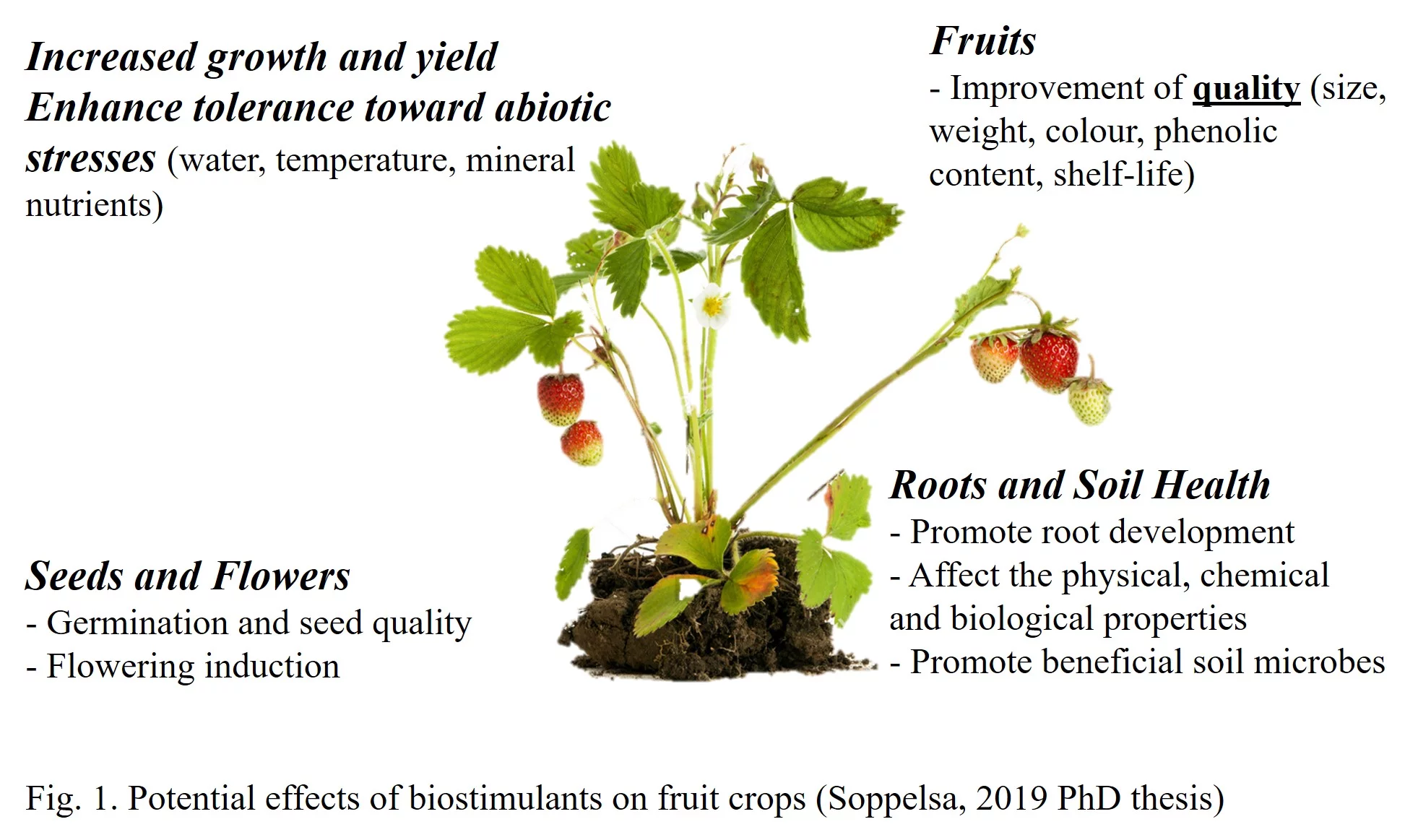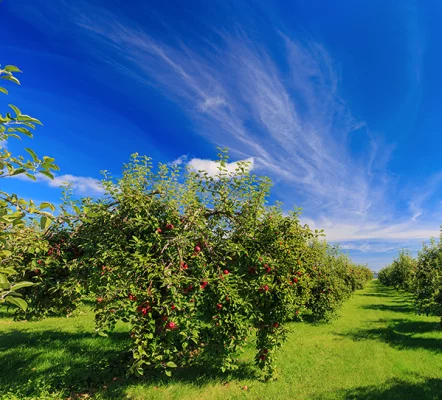USE OF BIOSTIMULANTS TO INCREASE FRUIT CROP PERFORMANCES
By: Carlo Andreotti1 and Boris Basile2
1Faculty of Science and Technology, Free University of Bozen-Bolzano, Italy. Email: carlo.andreotti@unibz.it
2Department of Agricultural Sciences, University of Naples Federico II, Italy. Email: boris.basile@unina.it

The fruit industry is actively searching for new technologies to increase the sustainability of the production systems and to improve the final quality of fresh produce. Biostimulants are bio-technological innovations that can bridge together different bio-based industries in the perspective of a more circular economy. Microbial and non-microbial biostimulants are already available on the market for fruit growers, even though the current knowledge on the interaction between these substances and the vegetative and reproductive physiology of fruit trees is still largely incomplete. Scientific literature is often inconsistent about the efficacy and suitability of biostimulants for fruit trees under different growing conditions. This may be due to constitutive aspects of plant physiology strictly related to the perennial nature of fruit trees, such as the level of metabolic reserves stored in storage organs and its interaction with variable year-to-year climatic conditions.
Following the classification based on the functional claims currently used for the biostimulants definition [in some regions], below we provide some general indications about their use in the fruit industry.
Use of biostimulants to increase tolerance of fruit tree crops to abiotic stresses.
Tolerance toward water stress was achieved after arbuscular mycorrhizal fungi (AMF) inoculum in citrus and grapevine trees under water shortage. Increased tolerance is generally explained by an increased water uptake by the root systems after inoculation, combined with higher concentration of osmolytes (proline, glycin betaine, sugars) which act as protective agents at cells level.
Mycorrhization was also reported to contrast the negative consequences of salinity in apple, citrus, grapevine and strawberry. It must be carefully considered that the majority of the studies with AMF was conducted under controlled conditions (potted plants in greenhouse and/or in-vitro culture), therefore leaving many unanswered questions related to the efficacy of these microorganisms on trees grown in open-field conditions.
Canopy applications of other microbial biostimulants (i.e. plant growth promoting bacteria, PGPB) increased cold tolerance in grapevine. The mode of action of PGPB involves a higher accumulation of cold-stress-related metabolites (starch, proline, and phenolics) in plant tissue in combination with an enhanced scavenging activity provided by several antioxidant compounds. Damages caused by high temperatures often occur at the level of the fruit skin tissues in apple and other species, causing sunburn necrosis. The incidence and severity of necrosis was found to be reduced by the foliar application of a natural product obtained from carnauba palm leaves, which provided an UV filtering effect on fruits, without causing neither phytotoxicity in leaves nor changes in leaf gas exchange.

Use of biostimulants to enhance nutrient use efficiency in fruit tree crops.
Microbial (AMF and PGPB) and non-microbial biostimulants (humic acids, protein hydrolysates, seaweeds extracts) can contrast nutrients limitation thanks to several synergic modes of action. AMF and PGPB were reported to increase the capacity of the root system to grow and explore larger portion of soil volume, whereas humic and fulvic acids partially modified the soil physico-chemical properties (e.g. pH, cation exchange capacity), increasing the nutrient availability for specific mineral nutrients while reducing the leaching losses of others.
The enhanced nutrient uptake in response to AMF inoculation have been described in many fruit tree crops, including apple and citrus species. However, also for this topic, it is evident a current lack of experimental evidences on the efficacy of AMF of PGPB in standard orchard under open field conditions. In grapevine and in some stone fruit species, the application of selected biostimulants helped to contrast the stunted vegetative growth caused by the lack of selected macro and micronutrients. Magnesium deficiency was reduced in grapevine treated with a seaweed extract and this may be useful to reduce the incidence of the bunch stem necrosis. In cherry trees, soil application of humic and fulvic acids was reported to increase significantly zinc and iron uptake and this may help in reducing the onset of leaf chlorosis in calcareous soils. In strawberry plants, the seaweed application at the canopy successfully contrasted iron deficiency in leaves, providing results that did not differed significantly from those obtained with the environmentally harmful iron-chelates such as sequestrene.
Use of biostimulants to promote yield and quality of fruit tree crops.
The scientific evidences of a positive effect of biostimulants on crop yield has not been univocally achieved when fruit trees are considered. Differently from other annual crops (vegetables, cereals), perennial plants are highly influenced by the “carry-over” effects on growth, cropping and metabolic reserves accumulation from one season to the next. Within this framework, it is not surprising that more evident improvement of crop yield in fruit crops have been achieved on trees experiencing biotic or abiotic stresses (drought, nutrient limitation, pathogens), or in trees experiencing alternate bearing (i.e. in olive and apple trees).
The effects of selected biostimulants on final fruit quality are much more evident. The improvement of the final skin coloration (due to higher anthocyanin accumulation) and of the overall nutritional value (due to higher concentrations of phenolics and other antioxidant compounds) of fruits have been described in several tree crops after the application of biostimulant products. Seaweed and protein hydrolysates enhanced the red color of apples and grape berries cultivated in open field conditions, independently from the seasonal weather conditions and the cultivation area. Protein hydrolysates appeared to be effective also in increasing the final yeast available nitrogen in the grape must, with positive consequences for the fermentation processes. Humic acids fulvic acids applications increased fruit quality (sugar content, anthocyanin concentration and fruit size), whereas seaweed application reduced the incidence of cherry cracking due to rainfalls before harvest. Finally, selected biostimulants have shown some potentially interesting properties to be exploited for the management of the fruit storage period. As an example, the increased concentration of phenolics and other antioxidant compounds, found in apples treated with silicon and zinc-based biostimulants, was indicated as responsible for the lower incidence of post-harvest disorders in apple fruit at the end of the storage period.

To conclude, studies on the use of biostimulant products in the fruit production industry are still limited as compared to annual crops (vegetables, cereals, soybean, etc.) and the results obtained until now are not always consistent in terms of efficacy and repeatability. Nevertheless, selected biostimulant products showed some interesting effects especially with regard to the enhanced vegetative and reproductive growth performances under suboptimal growing conditions (e.g. nutrients and water limitation) and to the higher commercial quality of the products (e.g. nutritional and esthetical properties of fruits). Future research should: i) further investigate the mode of action of biostimulants’ active molecules within the fruit tree metabolism; ii) focus on the optimization of the method of application (dosages, timings, etc.); iii) better analyze the impact of the climatic/seasonal weather conditions on biostimulant performances in orchards and vineyards; iv) provide cost-benefit analysis in order to come to a sustainable implementation of the biostimulant use in the fruit industry.
You are invited to request access to the entire Research Article that this topic is based on here:
Basile, B., Rouphael, Y., Colla, G., Soppelsa, S. and Andreotti, C., 2020. Appraisal of emerging crop management opportunities in fruit trees, grapevines and berry crops facilitated by the application of biostimulants. Scientia Horticulturae, 267, p.109330. https://doi.org/10.1016/j.scienta.2020.109330



